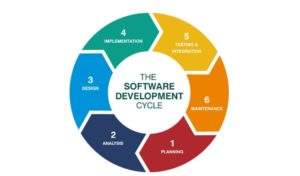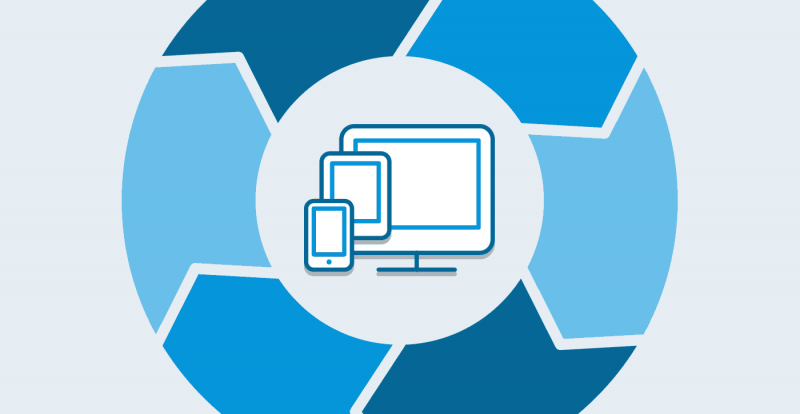SDLC means the Software Development Life Cycle. Developers all over the world know this abbreviation as the concept describing the software building process.
If you are just getting deep inside the world of software development, you need to understand the Software Development Life Cycle or SDLC. This brief post will help you to get a general idea of it and definу the best SDLC model among the following ones:
- Waterfall
- Agile
- Lean
- Iterative
- Spiral
- DevOps
Contents
What is the nature of SDLC methods?
The Software Development Life Cycle concept can be applied to technical and non-technical project management.
Any method included in SDLC typically involves project managers and program managers together with software engineers, developers, and end-users.
Every hardware or software system goes through an iterative development process with various steps. There are key Software Development Life Cycle stages that constitute a rigid structure of system development.
Any software engineer should have enough knowledge on how to choose the appropriate SDLC methodology based on the project context and business requirements.
Common Software Development Life Cycle steps
Any SDLC model consists of multiple steps. Though there can be no ideal number of stages, specialists usually define from 7 to 8 steps. However, this figure can vary from 5 to 12 depending on the case.
In general, SDLC methodologies comprise 7 stages:
- Analysis. Software developers evaluate the existing system and identify all possible deficiencies.
- Planning. Developers collect software requirements and come up with ideas to address the detected issues.
- Design. The development team takes into account hardware and operating systems, as well as programming, communication, and security issues.
- Development. Developers build and install new components and programs.
- Testing. The quality assurance team performs tests.
- Deployment. The system is incorporated into a production environment.
- Maintenance. This step involves changing and updating the system after it is up and running.

Among other steps, you can observe project initiation, functional specifications, detailed specifications, evaluation, etc.
Software Development Life Cycle models
Choosing the right SDLC model for your software development project requires a clear mind and careful thoughts.
To succeed, you’ll definitely need to gather a solid team ready to move the project forward through unexpected challenges or setbacks. However, the well-defined methodology may be the first ingredient of your project success. So, what are these powerful methodologies?
Waterfall
The traditional Waterfall model is one of the oldest SDLC approaches. Though more innovative methods have challenged its position, this model hasn’t lost its importance and power completely.
Those developers who are just starting their way and choosing the basics for work often face the choice of “Waterfall vs. Agile”, because these two methods are the most popular and widely used today.
The Waterfall methodology includes a rigid structure with a linear sequential flow. It means that any phase in the development process begins only if the previous one is complete. Teams must determine all system requirements at the project’s start and then begin the design and development stages.
Only after the product is completely developed, it is tested against the initial requirements and reworked. Even though the Waterfall model limits companies in flexibility, it remains a strong solution for certain types of projects.
Pros
- Well-defined stages and activities
- Structured approach
- Verification at each stage
- Specific deliverables at every step
Cons
- Difficulty to go back to any stage after it is finished
- Hard and expensive adjustments to the project scope
- Limited flexibility
- More time required
Click to learn more about the Waterfall model.
Agile
The Agile project management method can be considered as the opposite of the Waterfall approach. The methodology has recently become the major driving force behind software development in many companies and industries. Businesses with non-technical initiatives have also discovered the value of the Agile methodology for their projects.
Agile is based on ongoing release cycles. Each cycle features small incremental changes in the deliverables of the previous release. Each iteration of the product is tested. According to the Agile principles, work is usually broken into 2-4 weeks’ segments known as “Sprints.”
Agile teams are able to easily identify and solve project small problems before they evolve into more significant challenges. Agile works perfect in small companies, especially startups, where flexibility and speed are crucial.
Pros
- Less time required to avail system features
- Face-to-face communication with no space for guesses
- The minimal possible project time
- High-quality software and happy clients as a result
Cons
- Special skills required
- Limited scalability
- Documentation delivery at later stages
Click to learn more about the Agile model and Extreme Programming
Lean
The Lean approach is closely interconnected with Agile as they both focus on continuous improvement and the delivery speed.
Lean has come from Lean manufacturing practices. The methodology implies working only on the things that can be managed at a time without multitasking. The Lean method is based on seven key principles:
- Eliminate waste
- Amplify learning
- Decide as late possible
- Deliver as fast as possible
- Empower the team
- Build integrity
- Look holistically
Project teams that work according to the Lean methodology are focused on finding opportunities to cut waste at every turn throughout the SDLC process.
Lean emphasizes the elimination of waste as a way to create more value for customers and increase user buy-in. The model is the most compelling for companies with strict hardware requirements and other procurement needs.
Pros
- Decreased costs
- Maximized profits
- Improved interaction with customers
- Higher quality due to attention to detail
- Improvements in business culture
Cons
- It is difficult to change over. The lean approach adoption takes patience and a complete overhaul of the work processes.
- High implementation costs. Companies may be unprepared for the increased expenses of bringing in new equipment and training programs.
- The temptation to over-structure.
Click to learn more about the Lean model.
Iterative
What makes the Iterative model unique is that it takes the Waterfall method and cycles through it several times in small increments. It does not stretch the project across all SDLC phases; instead, each step becomes a series of mini-projects that add value.
The Iterative model sets many of the goals that the Agile methodology does. The key exception is that customers are less involved, and the scope of each increment is normally fixed.
The core advantage of the Iterative model is that it produces a working version of the project early in the process and makes it less expensive to implement changes. However, repetitive processes can quickly consume resources.
Pros
- Business value early in the development lifecycle
- More efficient using of scarce resources due to a proper increment definition
- More focus on value for the customer
Cons
- Heavy documentation requirements
- Definition of increments based on function and feature dependencies
- More customer involvement than with the linear approaches
- Easier development of problematic features due to task partitioning
Click to learn more about the Iterative model.
Spiral
The Spiral model is a combination of the Waterfall and Iterative model elements. Each phase begins with a design goal and ends with the client review.
The development team starts with a small set of requirements and goes through each stage to fulfill them. Spiral is known as one of the most flexible SDLC methodologies.
The Spiral model looks appropriate for large, complicated, and expensive projects as it gives development teams the opportunity to create a highly customized product and incorporate user feedback early on in the project.
The application of the Spiral approach also ensures high-quality risk management because each iteration starts by looking ahead to potential risks.
Pros
- Early involvement of developers
- More realistic estimations
- Early discovery of crucial issues
- Advanced risk management
Cons
- Special skills required to evaluate risks and assumptions
- High costs and time to reach the final product
Click to learn more about the Spiral model.
DevOps
DevOps is one of the newest SDLC methodologies. According to the model, developers and operational teams closely work together and sometimes as one team. This allows boosting innovations and deploying higher-quality and more reliable software products.
The DevOps method ensures that changes become more fluid, while organizational risks are reduced.
The method is characterized by small and frequent product updates, continuous feedback, process improvement, advanced discipline, and the automation of manual tasks.
Pros
- Quick development and deployment
- Fast response to the market changes to improve business growth
- Escalated business profits
- Decreased software delivery time and transportation costs
- Improved customer experience
Cons
- Rather expensive
- Limited availability of DevOps expert developers
- Much time required to adopt DevOps technologies
Click to learn more about the DevOps model.
Software Development Life Cycle methodologies help developers reach the highest level of control over the project management processes and documentation. By following particular approaches, development teams can better understand what they should build and why. The costs and required resources become transparent for all parties involved.
Of course, each methodology requires a more detailed study and consideration. However, even brief advantages and disadvantages of the models listed above can help you pick your favorites.





